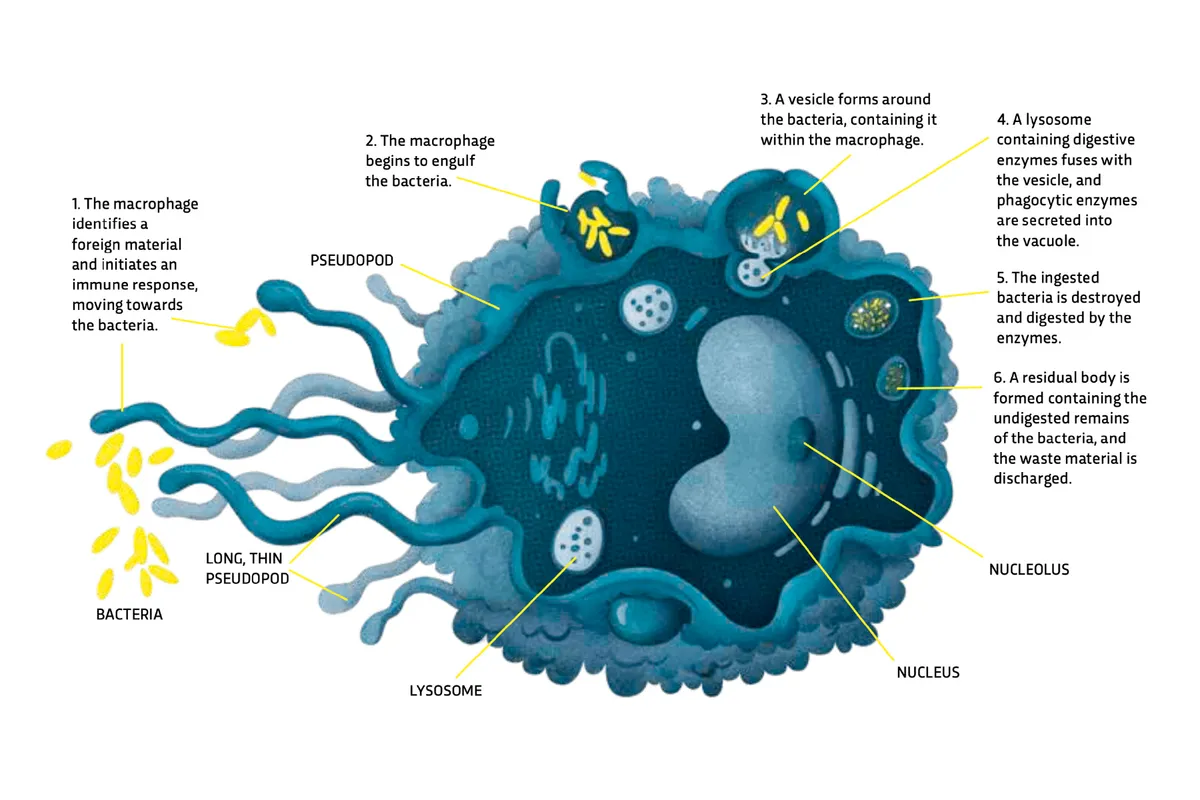As scavengers of the body, macrophages form an important part of the immune system. But how exactly does a macrophage destroy a pathogen? And once a macrophage engulfs a bacterium, what happens to the foreign cell? Read on for answers to this, and more.
What is a macrophage?
Macrophages are a type of white blood cell. They are large, specialised cells that help to eliminate foreign substances, microorganisms and other types of harmful organisms by engulfing them and initiating an immune response. They are important for helping to protect us from infection and are around 21 micrometres (0.021mm) in diameter - which is pretty big for a cell.
Macrophages are present in almost all tissues of the human body and are really, really cool.
Discover more about bacteria:
- Is there anywhere that’s completely bacteria-free?
- Scientists identify gut bacteria linked to neurodegenerative conditions
- Put down the disinfectant: Should we be encouraging helpful bacteria into our homes?
Where are macrophages made?
Like other white blood cells, macrophages are formed in the bone marrow. This is the soft, spongy tissue found in the centre of most bones.
Macrophages begin life as monocytes, which, once mature, only exist in the blood for around three to eight hours. Once they move into the tissues, however, they can mature into either macrophage cells or dendritic cells.
Dendritic cells act as an early warning system in the body. They are an antigen-presenting cell (APC) and help to boost immune responses by highlighting the presence of antigens to other cells in the immune system. Antigens are substances (molecules) foreign to the body, that stimulate an immune response.
During development, dendritic cells develop long branched projections, or 'dendrites', making them appear 'tree-like' in shape.
How does a macrophage destroy a pathogen?
Below is a labelled diagram, illustrating how a macrophage destroys a pathogen - in this case, bacteria, which is shown in yellow:

Step 1
The macrophage identifies a foreign material and initiates an immune response, moving towards the bacteria.
Step 2
The macrophage begins to engulf the bacteria, beginning the process of phagocytosis. The word derives from the Greek words phago, meaning to 'devour' or 'eat'; and cyte, the suffix in biology that means 'cell'. Together, phagocyte translates as 'cell devouring'.
The speed at which a particle is 'devoured' depends on its size. Small particles, like bacteria, are ingested almost instantaneously, while larger particles, like tissue cells or clumps of bacteria, take longer.
Step 3
A bubble-like membranous structure, or vesicle, forms around the bacteria, locking it within the macrophage. This vesicle is called a phagosome.
Step 4
A membrane-bound lysosome containing digestive enzymes fuses with the phagosome, and phagocytic enzymes (biological catalysts) are secreted into the vacuole.
Step 5
The ingested bacteria are destroyed and digested by the enzymes, as they mix together in the vacuole. However, there are certain types of bacteria, such as Mycobacterium tuberculosis, which have become resistant to these methods of digestion.
Step 6
A residual body is formed containing the undigested remains of the bacteria, and the waste material is discharged. The macrophage gets rid of this waste material through a process called exocytosis. This process requires energy, and it's important for rebuilding the cell membrane.
Macrophages can digest over 100 bacteria before they themselves finally die from their own digestive compounds.

What else do macrophages do?
As well as bacteria, viruses and other pathogens, macrophages also eat fat - which is a problem for people with atherosclerosis. This is when there is a build-up of fats, cholesterol and other substances in the arteries, called ‘plaques’. These plaques cause the arteries to narrow and harden.
As they consume the excess fat in the artery walls, the fat-filled macrophages become foamy. This encourages inflammation in the arteries and sometimes even breaks apart the plaque deposits, freeing clots that can cause heart attack, stroke or embolisms elsewhere in the body.
Macrophages also play a role in the body's circadian rhythm or 'body clock'. When scientists studied macrophages in mice, they found that a deficiency of the BMAL1 protein, which controls the 24-hour cycle of the macrophages, was linked with increased levels of inflammation.
Read more about the human body: